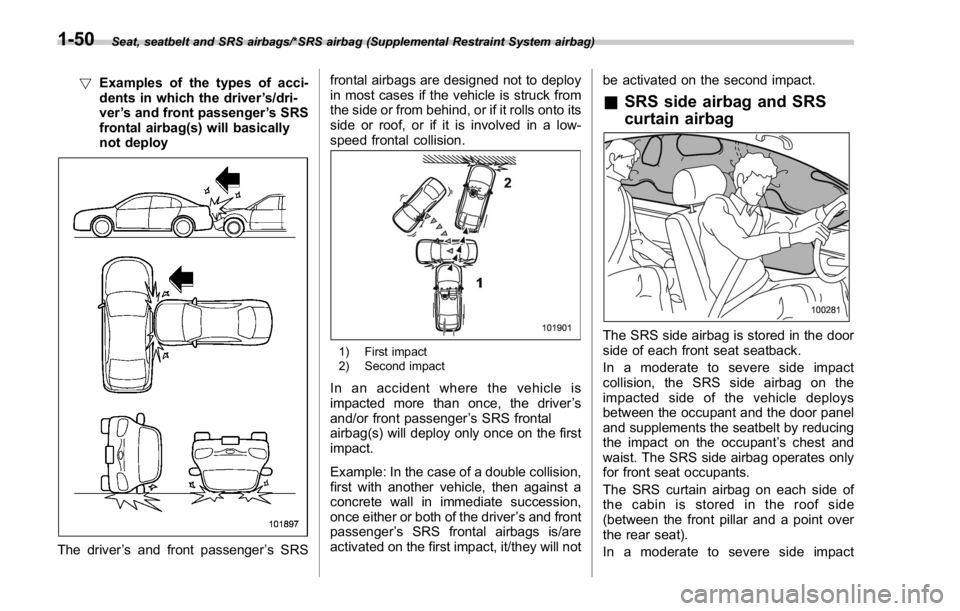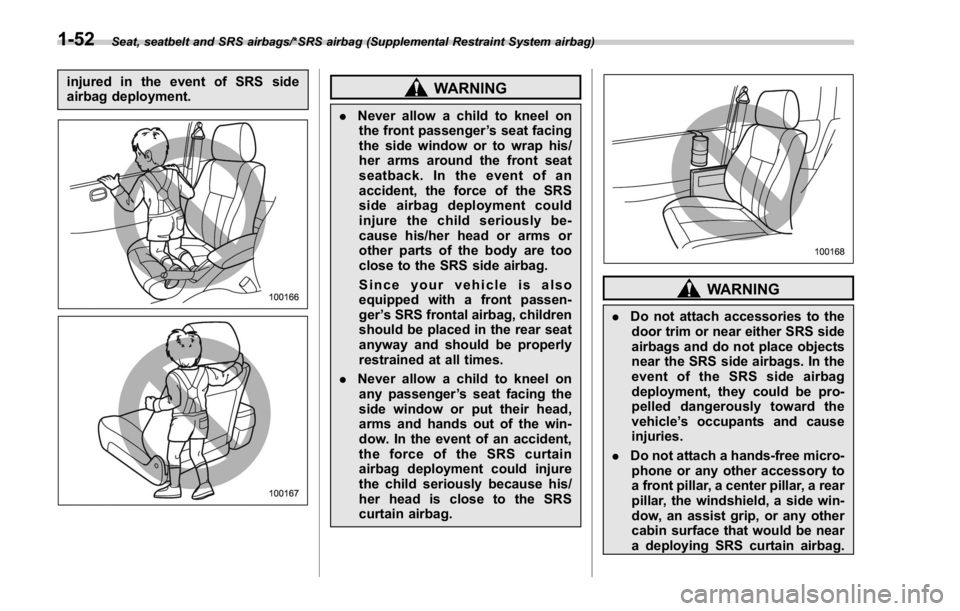2016 SUBARU WRX belt
[x] Cancel search: beltPage 76 of 594

The driver ’ s and front passenger ’ s SRS
frontal airbags use dual stage inflators.
The two inflators of each airbag are
triggered either sequentially or simulta-
neously, depending on the severity of
impact, in the case of the driver ’ s SRS
frontal airbag and depending on the
severity of impact and the characteristic
of item(s) or person on the seat in the case
of the front passenger ’ s SRS frontal
airbag.
After deployment, the SRS airbag imme-
diately starts to deflate so that the driver ’ s
vision is not obstructed. The time required
from detecting impact to the deflation of
the SRS airbag after deployment is short-
er than the blink of an eye.
Both when only the driver ’ s SRS frontal
airbag deploys and the driver ’ s and front
passenger ’ s SRS frontal airbags deploy,
the driver ’ s and front passenger ’ s seatbelt
pretensioners operate at the same time.
Although it is highly unlikely that the SRS
airbag would activate in a non-accident
situation, should it occur, the SRS airbag
will deflate quickly, not obscuring vision
and will not interfere with the driver ’ s
ability to maintain control of the vehicle.
When the SRS airbag deploys, a sudden,
fairly loud inflation noise will be heard and some smoke will be released. These
occurrences are a normal result of the
deployment. This smoke does not indicate
a fire in the vehicle.
CAUTIONDo not touch the SRS airbag system
components around the steering
wheel and dashboard with bare
hands right after deployment. Doing
so can cause burns because the
components can be very hot as a
result of deployment.
The driver ’ s SRS frontal airbag and front
passenger ’ s SRS frontal airbag are de-
signed to deploy in the event of an
accident involving a moderate to severe
frontal collision. They are not designed to
deploy in most lesser frontal impacts
because the necessary protection can be
achieved by the seatbelt alone. Also, they
are not designed to deploy in most side or
rear impacts or in most roll-over accidents
because deployment of only the driver ’ s
SRS frontal airbag or both driver ’ s and
front passenger ’ s SRS frontal airbags
would not help the occupant in those
situations. The driver ’ s and front passen-
ger ’ s SRS frontal airbags are designed to
function on a one-time-only basis. SRS airbag deployment depends on the
level of force experienced in the passen-
ger compartment during a collision. That
level differs from one type of collision to
another, and it may have no bearing on
the visible damage done to the vehicle
itself.
! Example of accident in which the
driver ’ s/driver ’ s and front pas-
senger ’ s SRS frontal airbag(s)
will most likely deploy
A head-on collision against a thick con-
crete wall at a vehicle speed of 12 to 19
mph (20 to 30 km/h) or higher activates
only the driver ’ s SRS frontal airbag or both
driver ’ s and front passenger ’ s SRS frontal
airbags. The airbag(s) will also be acti-
vated when the vehicle is exposed to a
frontal impact similar in fashion andSeat, seatbelt and SRS airbags/*SRS airbag (Supplemental Restraint System airbag)
– CONTINUED –1-47
Page 77 of 594

Seat, seatbelt and SRS airbags/*SRS airbag (Supplemental Restraint System airbag)
magnitude to the collision described
above. ! Examples of the types of acci-
dents in which it is possible that
the driver ’ s/driver ’ s and front
passenger ’ s SRS frontal
airbag(s) will deploy Only the driver ’ s SRS frontal airbag or
both driver ’ s and front passenger ’ s SRS
frontal airbags may be activated when the
vehicle sustains a hard impact in the
undercarriage area from the road surface
(such as when the vehicle plunges into a
deep ditch, is severely impacted or
knocked hard against an obstacle on the
road such as a curb).1-48
Page 78 of 594

! Examples of the types of accidents in which deployment of the driver ’ s/
driver ’ s and front passenger ’ s SRS frontal airbag(s) is unlikely to occur 1) The vehicle strikes an object, such as a
telephone pole or sign pole.
2) The vehicle slides under the load bed of
a truck.
3) The vehicle sustains an oblique offset
frontal impact.
4) The vehicle sustains an offset frontal
collision.
5) The vehicle strikes an object that can
move or deform, such as a parked
vehicle.
There are many types of collisions which
might not necessarily require deployment
of driver ’ s/driver ’ s and front passenger ’ s
SRS frontal airbag(s). In the event of
accidents like those illustrated, the dri-
ver ’ s/driver ’ s and front passenger ’ s SRS
frontal airbag(s) may not deploy depend-
ing on the level of accident forces in-
volved.Seat, seatbelt and SRS airbags/*SRS airbag (Supplemental Restraint System airbag)
– CONTINUED –1-49
Page 79 of 594

Seat, seatbelt and SRS airbags/*SRS airbag (Supplemental Restraint System airbag)
! Examples of the types of acci-
dents in which the driver ’ s/dri-
ver ’ s and front passenger ’ s SRS
frontal airbag(s) will basically
not deploy
The driver ’ s and front passenger ’ s SRS frontal airbags are designed not to deploy
in most cases if the vehicle is struck from
the side or from behind, or if it rolls onto its
side or roof, or if it is involved in a low-
speed frontal collision.
1) First impact
2) Second impact
In an accident where the vehicle is
impacted more than once, the driver ’ s
and/or front passenger ’ s SRS frontal
airbag(s) will deploy only once on the first
impact.
Example: In the case of a double collision,
first with another vehicle, then against a
concrete wall in immediate succession,
once either or both of the driver ’ s and front
passenger ’ s SRS frontal airbags is/are
activated on the first impact, it/they will not be activated on the second impact.
& SRS side airbag and SRS
curtain airbag
The SRS side airbag is stored in the door
side of each front seat seatback.
Inamoderatetoseveresideimpact
collision, the SRS side airbag on the
impacted side of the vehicle deploys
between the occupant and the door panel
and supplements the seatbelt by reducing
the impact on the occupant ’ s chest and
waist. The SRS side airbag operates only
for front seat occupants.
The SRS curtain airbag on each side of
the cabin is stored in the roof side
(between the front pillar and a point over
the rear seat).
Inamoderatetoseveresideimpact1-50
Page 80 of 594

collision, the SRS curtain airbag on the
impacted side of the vehicle deploys
between the occupant and the side
window and supplements the seatbelt by
reducing the impact on the occupant ’ s
head.
In a frontal collision, SRS curtain airbags
on both sides of the vehicle deploy
between the occupant and the side
window and supplement the seatbelt by
reducing the impact to the occupant ’ s
head.
WARNINGThe SRS side airbag and SRS
curtain airbag are designed only to
be a supplement to the primary
protection provided by the seatbelt.
They do not do away with the need
to fasten seatbelts. It is also impor-
tant to wear your seatbelt to help
avoid injuries that can result when
an occupant is not seated in a
proper upright position. WARNING. Do not sit or lean unnecessarily
close to either front door. The
SRS side airbag is stored in both
front seat seatbacks next to the
door, and it provides protection
by deploying rapidly (faster than
the blink of an eye) in the event of
a side impact collision. However,
theforceofSRSsideairbag
deployment may cause injuries
if your head or other parts of the
body are too close to the SRS
side airbag.
. Since your vehicle is equipped
with SRS curtain airbags, do not
sit or lean unnecessarily close to the front or rear door on either
side. Also, do not put your head,
arms or hands out of the window.
The SRS curtain airbag on each
side of the cabin is stored in the
roof side (between the front pillar
and a point over the rear seat),
and it provides protection by
deploying rapidly (faster than
the blink of an eye) in the event
of a side impact. However, the
force of its deployment may
cause injuries if your head is
too close to it.
WARNING
Do not rest your arm on either front
door or its internal trim. It could beSeat, seatbelt and SRS airbags/*SRS airbag (Supplemental Restraint System airbag)
– CONTINUED –1-51
Page 81 of 594

Seat, seatbelt and SRS airbags/*SRS airbag (Supplemental Restraint System airbag)
injured in the event of SRS side
airbag deployment.
WARNING. Never allow a child to kneel on
the front passenger ’ s seat facing
the side window or to wrap his/
her arms around the front seat
seatback. In the event of an
accident, the force of the SRS
side airbag deployment could
injure the child seriously be-
cause his/her head or arms or
other parts of the body are too
close to the SRS side airbag.
Since your vehicle is also
equipped with a front passen-
ger ’ s SRS frontal airbag, children
should be placed in the rear seat
anyway and should be properly
restrained at all times.
. Never allow a child to kneel on
any passenger ’ s seat facing the
side window or put their head,
arms and hands out of the win-
dow. In the event of an accident,
the force of the SRS curtain
airbag deployment could injure
the child seriously because his/
her head is close to the SRS
curtain airbag. WARNING. Do not attach accessories to the
door trim or near either SRS side
airbags and do not place objects
near the SRS side airbags. In the
event of the SRS side airbag
deployment, they could be pro-
pelled dangerously toward the
vehicle ’ s occupants and cause
injuries.
. Do not attach a hands-free micro-
phone or any other accessory to
a front pillar, a center pillar, a rear
pillar, the windshield, a side win-
dow, an assist grip, or any other
cabin surface that would be near
a deploying SRS curtain airbag.1-52
Page 82 of 594

A hands-free microphone or
other accessory in such a loca-
tion could be propelled through
the cabin with great force by the
curtain airbag, or it could prevent
correct deployment of the curtain
airbag. In either case, the result
could be serious injuries.
. Never hang or place coat hangers
or other hard or pointed objects
near the side windows. If such
items are present when the SRS
curtain airbags deploy, they
could be thrown through the
passenger compartment and
cause serious injuries. They
could also prevent proper opera-
tion of the SRS curtain airbags. WARNINGDo not put any kind of cover or
clothes or other objects over either
front seatback and do not attach
labels or stickers to the front seat
surface on or near the SRS side
airbag. They could prevent proper
deployment of the SRS side airbag,
reducing protection available to the
front seat ’ s occupant.
! Operation
The SRS side airbag and SRS curtain
airbag can function only when the ignition
switch is in the “ ON ” position.
The driver ’ s and front passenger ’ s SRS
side airbags and SRS curtain airbags
deploy independently of each other since
each has its own impact sensor. There-
fore, they may not both deploy in the same
accident. Also, the SRS side airbag and
SRS curtain airbag deploys independently
of the driver ’ s and front passenger ’ s SRS
frontal airbags in the steering wheel and
instrument panel.
An impact sensor, which senses impact
force, is located in each of the following
locations.
. In the left and right front doors . In the left and right center pillars
. In the left and right rear wheel houses
. Under the rear center seat
If the impact sensor that is located under
the rear center seat and one of the center
pillar impact sensors or front door impact
sensors together sense an impact force
above a predetermined level in a side
collision, the control module causes both
the SRS side airbag and curtain airbag on
the impacted side to inflate regardless of
whether the rear wheel house impact
sensor on the same side senses an
impact.
If the impact sensor that is located under
the rear center seat and one of the rear
wheel house impact sensors together
sense an impact force above a predeter-
mined level in a side collision, the control
module causes only the SRS curtain
airbag on the impacted side to inflate.
Even if a frontal collision occurs, the SRS
curtain airbags will deploy when the front
sensor and the control unit determine that
the impact results from an offset frontal
collision.
The SRS curtain airbags are designed to
deploy when the driver ’ s SRS frontal
airbag deploys or the driver ’ s and pas-
senger ’ s SRS frontal airbags deploy in aSeat, seatbelt and SRS airbags/*SRS airbag (Supplemental Restraint System airbag)
– CONTINUED –1-53
Page 83 of 594

Seat, seatbelt and SRS airbags/*SRS airbag (Supplemental Restraint System airbag)
frontal collision, and also when the system
determines that the collision is an offset
frontal collision. The SRS curtain airbags
are basically designed not to deploy in a
frontal collision when the SRS frontal
airbags do not deploy or the system
determines that the collision is other than
an offset frontal collision.
After the deployment, the SRS side airbag
immediately starts to deflate. The time
required from detection of an impact to
deflation of an SRS side airbag after
deployment is shorter than the blink of
an eye.
The SRS curtain airbag remains inflated
for a while following deployment then
slowly deflates.
The SRS side airbag and SRS curtain
airbag deploy even when no one occupies
the seat on the side on which an impact is
applied.
When the SRS side airbag and SRS
curtain airbag deploy, a sudden, fairly loud
inflation noise will be heard and some
smoke will be released. These occur-
rences are a normal result of the deploy-
ment. This smoke does not indicate a fire
in the vehicle. CAUTIONDo not touch the SRS side airbag
system components around the
front seat seatback with bare hands
right after deployment. Doing so can
cause burns because the compo-
nents can be very hot as a result of
deployment.
After deployment, do not touch any
part of the SRS curtain airbag
system (from the front pillar to the
part of the roof side over the rear
seat). Doing so can cause burns
because the components can be
very hot as a result of deployment.
The SRS side airbag and SRS curtain
airbag are designed to deploy in the event
of an accident involving a moderate to
severe side impact collision. They are not
designed to deploy in most lesser side
impact. Also, they are not designed to
deploy in most frontal or most rear impacts
because SRS side airbag and SRS
curtain airbag deployment would not help
the occupant in those situations.
Each SRS side airbag and SRS curtain
airbag are designed to function on a one-
time-only basis.
SRS side airbag and SRS curtain airbag deployment depend on the level of force
experienced in the passenger compart-
ment during a side impact collision. That
level differs from one type of collision to
another, and it may have no bearing on
the visible damage done to the vehicle
itself.
1-54